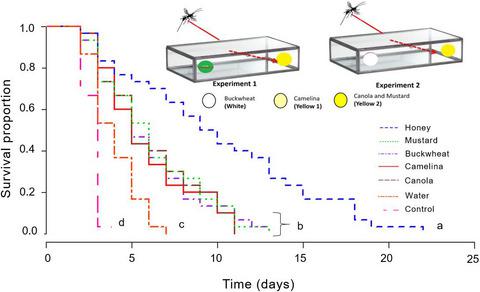当前位置:
X-MOL 学术
›
Entomol. Exp. Appl.
›
论文详情
Our official English website, www.x-mol.net, welcomes your
feedback! (Note: you will need to create a separate account there.)
Color, odor, and species preferences of Copidosoma bakeri to prospective cover crops to enhance control of cutworms
Entomologia Experimentalis et Applicata ( IF 1.4 ) Pub Date : 2021-02-12 , DOI: 10.1111/eea.13030 R.W.M. Udari M. Wanigasekara 1 , Alejandro C. Costamagna 1 , Yvonne E. Lawley 2 , Barbara J. Sharanowski 3
Entomologia Experimentalis et Applicata ( IF 1.4 ) Pub Date : 2021-02-12 , DOI: 10.1111/eea.13030 R.W.M. Udari M. Wanigasekara 1 , Alejandro C. Costamagna 1 , Yvonne E. Lawley 2 , Barbara J. Sharanowski 3
Affiliation

|
Cutworms (Lepidoptera: Noctuidae) are economically important pests of multiple field crops, but are difficult to control with insecticides. Biological control with native parasitoids may offer a sustainable alternative for pest management. Cover crops improve the availability of resources required by parasitoids to increase their effectiveness as biocontrol agents. Copidosoma spp. (Hymenoptera: Encyrtidae) have the potential to control several species of cutworms in the Canadian Prairies. However, their foraging preferences for non‐host food items are unknown. In this study, we tested flower color and odor preferences of Copidosoma bakeri (Howard) across nine potential cover crop species and investigated how these resources affect survival and longevity of the female wasps. Results indicated that the wasps were most attracted to plants with yellow flowers in the family Brassicaceae (i.e., camelina, mustard, and canola). In multiple‐choice tests, the wasps preferred camelina over all other flower species, and showed an intermediate preference for mustard and canola. In dual‐choice tests with color paper, the wasps preferred yellow over white, and the light yellow of camelina over the bright yellow of canola and mustard, whereas they showed a preference for the odors of mustard and canola. Life expectancy was increased when the wasps were provided floral resources compared to the absence of a food source. Later planting dates and mixed‐species plantings of cover crops resulted in flowering times that better coincided with native wasp emergence. Camelina is known to suppress weeds and may be used as a habitat management tool for enhancing parasitism of cutworms by C. bakeri in the Canadian Prairies. However, further testing is needed to achieve late flowering well into August and early September and to ensure planting additional Brassica spp. does not attract more late‐season pests to cash crops such as canola.
中文翻译:

面包钩虫的颜色,气味和物种偏爱于潜在的被覆作物,以增强对角虫的控制
地老虎(鳞翅目:夜蛾科)是多种田间作物的重要经济害虫,但很难用杀虫剂防治。天然寄生虫的生物防治可能为有害生物管理提供可持续的替代方法。覆盖作物提高了寄生物所需的资源的利用率,从而提高了其作为生物防治剂的效力。Copidosoma属。(膜翅目:Encyrtidae)有可能控制加拿大大草原的几种鳞翅目昆虫。但是,他们对非寄主食品的觅食偏好仍然未知。在这项研究中,我们测试了面包酵母Copidosoma bakeri的花色和气味偏好(霍华德)研究了九种潜在的覆盖作物物种,并研究了这些资源如何影响雌性黄蜂的生存和寿命。结果表明,黄蜂对十字花科的黄色花朵植物(如茶花,芥末和低芥酸菜子)最有吸引力。在多项选择测试中,黄蜂比其他所有花卉品种都更喜欢山茶花,并且表现出对芥末和低芥酸菜子的中等偏爱。在用彩色纸进行的双重选择测试中,黄蜂比黄色偏爱黄色,而黄芥末比油菜和芥末的鲜黄色更偏黄,而山茶花的浅黄色对芥末和油菜的偏香表示偏爱。与没有食物来源相比,向黄蜂提供花卉资源可以增加预期寿命。较晚的播种日期和有盖作物的混种种植导致开花时间与原生黄蜂的出现更好地吻合。骆驼科植物已知可以抑制杂草,可以用作栖息地管理工具,通过Ç。面包在加拿大大草原。但是,需要进一步测试才能使开花期延长至8月和9月初,并确保种植更多的芸苔属。不会在油菜籽等经济作物上吸引更多的后期害虫。
更新日期:2021-03-22
中文翻译:

面包钩虫的颜色,气味和物种偏爱于潜在的被覆作物,以增强对角虫的控制
地老虎(鳞翅目:夜蛾科)是多种田间作物的重要经济害虫,但很难用杀虫剂防治。天然寄生虫的生物防治可能为有害生物管理提供可持续的替代方法。覆盖作物提高了寄生物所需的资源的利用率,从而提高了其作为生物防治剂的效力。Copidosoma属。(膜翅目:Encyrtidae)有可能控制加拿大大草原的几种鳞翅目昆虫。但是,他们对非寄主食品的觅食偏好仍然未知。在这项研究中,我们测试了面包酵母Copidosoma bakeri的花色和气味偏好(霍华德)研究了九种潜在的覆盖作物物种,并研究了这些资源如何影响雌性黄蜂的生存和寿命。结果表明,黄蜂对十字花科的黄色花朵植物(如茶花,芥末和低芥酸菜子)最有吸引力。在多项选择测试中,黄蜂比其他所有花卉品种都更喜欢山茶花,并且表现出对芥末和低芥酸菜子的中等偏爱。在用彩色纸进行的双重选择测试中,黄蜂比黄色偏爱黄色,而黄芥末比油菜和芥末的鲜黄色更偏黄,而山茶花的浅黄色对芥末和油菜的偏香表示偏爱。与没有食物来源相比,向黄蜂提供花卉资源可以增加预期寿命。较晚的播种日期和有盖作物的混种种植导致开花时间与原生黄蜂的出现更好地吻合。骆驼科植物已知可以抑制杂草,可以用作栖息地管理工具,通过Ç。面包在加拿大大草原。但是,需要进一步测试才能使开花期延长至8月和9月初,并确保种植更多的芸苔属。不会在油菜籽等经济作物上吸引更多的后期害虫。









































 京公网安备 11010802027423号
京公网安备 11010802027423号